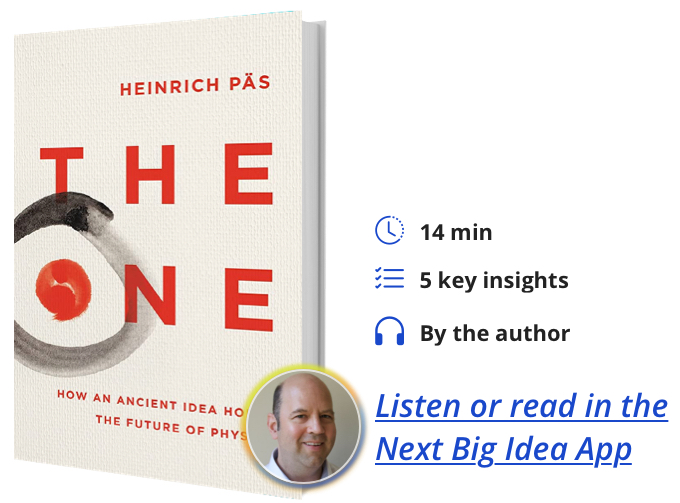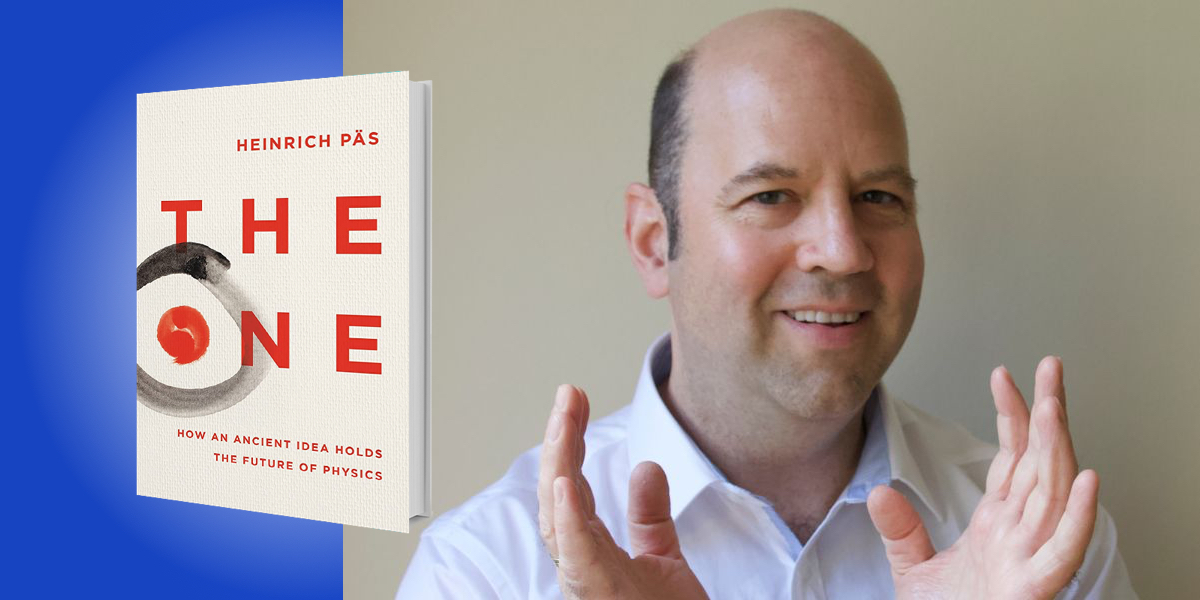Heinrich Päs is a theoretical physicist and professor at TU Dortmund University. His research on particle physics, cosmology and the structure of space and time was on the cover of the Scientific American and the New Scientist magazine.
Below, Heinrich shares 5 key insights from his new book, The One: How an Ancient Idea Holds the Future of Physics. Listen to the audio version—read by Heinrich himself—in the Next Big Idea App.

1. There exists a hidden “quantum reality” behind what we experience.
If you look out of the window you may see a street, cars, people, maybe a tree. Are these things the fundamental reality, or are they more like what you make out of the fundamental reality? When Niels Bohr and Werner Heisenberg worked on the foundations of quantum mechanics in 1927 in Copenhagen, they stumbled upon this exact question.
What they realized was that the same things in nature, such as light, could appear both as particles or as waves. However, one can never experience both these aspects at the same time. Heisenberg’s friend and collaborator Wolfgang Pauli tried to illustrate this finding by saying one could look at nature with two different eyes, seeing either particles or waves, but if one would open both eyes together one would go astray. So, is there a hidden reality that unifies the experiences of things as particles or waves?
Bohr, Heisenberg, and Pauli didn’t think so. When they tried to make sense out of this, they came to the conclusion that what we see is real and that there is no underlying, more fundamental quantum reality hiding behind. According to this Copenhagen interpretation, quantum mechanics doesn’t describe a deeper reality but merely our incomplete knowledge of nature. For many years to come, this view became the orthodox interpretation about what quantum mechanics meant.
“According to this Copenhagen interpretation, quantum mechanics doesn’t describe a deeper reality but merely our incomplete knowledge of nature.”
The opposing position, that there actually exists a quantum reality, was advocated early on by luminaries such as Albert Einstein and Erwin Schrödinger, yet it remained the view of a few outsiders. Over the last decades, however, many hints emerged that the quantum reality behind our experience actually exists, and how our experience originates from this deeper layer of reality. These hints included the realization of increasingly large quantum systems, objects as large as a millimeter, or the proof of quantum properties of light over hundreds of kilometers (including some of the experiments awarded with the 2022 physics Nobel prize). Most important, however, was the discovery of a process known as decoherence, that explains perfectly how quantum reality becomes what we see.
2. This hidden reality is one single, unified whole.
If there exists a hidden reality beyond what we experience, what is it? If you ask me, it is the most remarkable thing one could possibly think of. It is one single seamless whole that encompasses and unifies everything one can see, observe, or measure in the entire universe. The reason for why I think so is the quantum phenomenon known as entanglement. Entanglement is a property of quantum objects that are composed out of smaller parts. The striking thing about entanglement is that while you may know everything there is to know about the composed system, you still may know nothing about the constituents.
Leonard Susskind, one of the pioneers of string theory, has compared this to a mechanic who claims he knows everything about your car but unfortunately can’t tell you anything about any of its parts. “I know all about your car,” he may boast, “but unfortunately nothing about the brakes, or the wheels, or the motor.”
The reason why this make sense in quantum mechanics is that quantum objects are made of waves. As an illustration, picture a perfectly calm, glassy sea on a windless day. Now ask yourself, how can such a plane be produced by overlaying two individual wave patterns? One possibility is that superimposing two completely flat surfaces results again in a completely level outcome. But another possibility that might produce a flat surface is if two identical wave patterns were to be superimposed on one another, shifted in a way so that the wave crests of one pattern annihilate the wave troughs of the other one and vice versa. If we just observed the glassy ocean, regarding it as the result of two swells combined, there would be no way for us to find out about the patterns of the individual swells. Similar for composed quantum objects, their constituents aren’t really in a well-defined state; they don’t really exist until we pin them down by experiment, thereby destroying the original whole.
3. The plurality of objects we experience in our daily lives is a consequence of our perspective onto this undivided whole.
If all is one, why do we experience the universe as a plurality of things? The answer is a quantum process known as decoherence. To understand what happens when we observe something, we first have to think of the universe as split into us (the observer), the object to be observed, and the rest of the universe (the environment). During an act of observation, the observer interacts with the object, and at the same time, she interacts with the environment, as she can’t be entirely isolated from her surroundings. These interactions lead to entanglement, but since the observer doesn’t know the environment—after all, nobody knows the entire universe—from her perspective the information stored in the environment is inaccessible. It is this inaccessible information that constitutes the glue that unifies the world into a single whole.
“During an act of observation, the observer interacts with the object, and at the same time, she interacts with the environment, as she can’t be entirely isolated from her surroundings.”
While the universe still remains an entangled quantum object in its entirety, from the viewpoint of the observer it looks broken up, dissolved into many things. Fundamentally the whole is not really destroyed, it is still One, it only looks destroyed from the specific perspective of the observer. Thus, fundamentally, individual things are an illusion.
4. Such monistic philosophies are unpopular since they have been suppressed for centuries in the West.
To understand why these monistic implications of quantum mechanics aren’t more prominent, you must explore the history of monism in the West. What I discovered was this remarkable story that is just as exciting and dramatic as a Dan Brown novel.
Monism, the idea that “all is One” is often associated with East-Asian philosophy or religion. I was surprised to find that monism was actually quite common in the West in ancient times. There exists, for example, evidence that the Egyptians believed in a God that was all things, pervading everything, and early Greek philosophers such as Heraclitus and Parmenides wrote about an all-encompassing One. Plato, arguably the most influential philosopher ever, taught monism as a secret doctrine at his academy, to be disseminated only orally.
For some time, Platonism competed with Christianity to become the dominant world view in the Roman empire. Christianity finally prevailed in these struggles but adopted Platonic ideas, identifying the One with God. But Christianity drew also on other influences such as dualism, the idea that the universe is caught in an eternal struggle between “good” and “evil”— angels and demons, heaven and hell, etc.
To make these conflicting influences consistent, God aka The One was pushed into an otherworldly beyond. God wasn’t identified with nature anymore but thought of as opposed to nature. This also had political reasons: A God that is everywhere and pervades everything doesn’t require a cast of priests as an intermediary for the believer to get in contact with, and this cast of priests was the backbone of the political power of the church in late antiquity and the Middle Ages. Everyone who would dare to mix up God with nature or nature with a monistic One was prosecuted. People were condemned as possessed by the devil, they were burnt alive, their tongues were ripped out, remains were exhumed from graves and cast into unconsecrated ground.
“God wasn’t identified with nature anymore but thought of as opposed to nature.”
Yet monism resurfaced again and again. It inspired the art of Botticelli and Leonardo da Vinci, the music of Mozart and Beethoven, and the poems of Goethe and Coleridge, as well as the science of Newton, Faraday, and Einstein. Still, the message the church wanted to convey somehow stuck: religion had exclusive rights for the big picture, and science needs to be confined to filling out the details and producing recipes for problem solving. Scientists internalized that monism and nature, or monism and science, don’t belong together; that the hypothesis that “all is One” simply isn’t proper science.
5. We have to take monism serious as a consequence of quantum mechanics to make further progress in fundamental physics.
So why does it matter? Many physicists will think that all this may be true or not, but that it doesn’t really matter. To them, physics means to develop mathematical models, use them to calculate things, and compare the results with experiment. It does just fine without any such metaphysical pondering. Fact is, it doesn’t. Right now, fundamental physics is facing a crisis that forces us to rethink what we understand as fundamental in the first place.
In our best theories, there are extremely unlikely coincidences that so far defy any explanation. At the same time, the quest for a theory of everything is bereaving physics of its foundational concepts, such as matter, space, and time. If these are gone, what remains? So far we have tried to understand the universe in terms of increasingly small building blocks: Things are thought to be made of atoms, atoms are made of elementary particles such as quarks or electrons, and quarks and electrons may be tiny, oscillating strings, according to string theory.
In my opinion, it is time to rethink how far this approach is justified. It is time to take quantum mechanics seriously and build physics on a foundation that is the entire universe, not tiny particles or strings. Indeed, there are innovative and promising new research ideas that explore what such a paradigm shift could imply for physics. Particle physicists are studying whether the physics of very small and very large objects may be related, and string theorists discuss whether space and time may emerge from a unified, fundamental quantum description. To fully unfold their potential, it will be necessary to unveil and reflect on the philosophy underlying such approaches: Monism, the idea that at the most fundamental level, all is one.
To listen to the audio version read by author Heinrich Päs, download the Next Big Idea App today:































